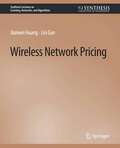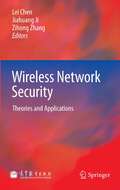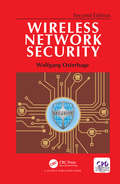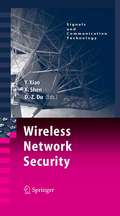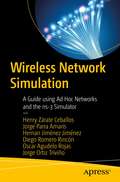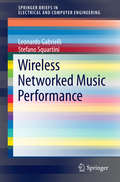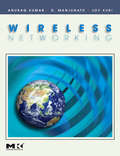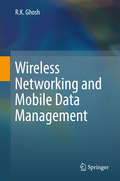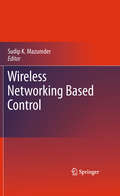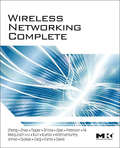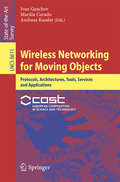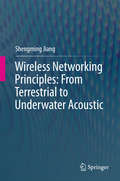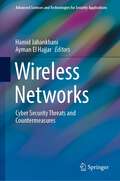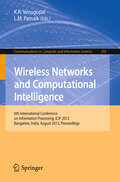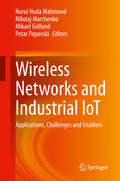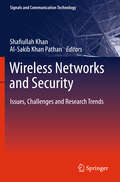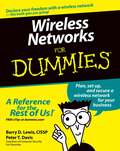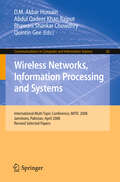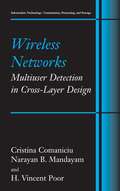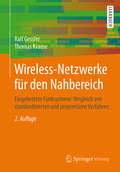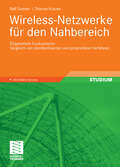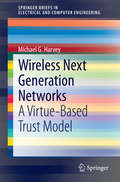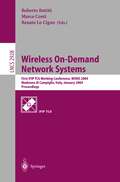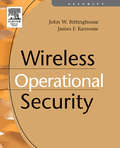- Table View
- List View
Wireless Network Pricing (Synthesis Lectures on Learning, Networks, and Algorithms)
by Jianwei Huang Lin GaoToday's wireless communications and networking practices are tightly coupled with economic considerations, to the extent that it is almost impossible to make a sound technology choice without understanding the corresponding economic implications. This book aims at providing a foundational introduction on how microeconomics, and pricing theory in particular, can help us to understand and build better wireless networks. The book can be used as lecture notes for a course in the field of network economics, or a reference book for wireless engineers and applied economists to understand how pricing mechanisms influence the fast growing modern wireless industry. This book first covers the basics of wireless communication technologies and microeconomics, before going in-depth about several pricing models and their wireless applications. The pricing models include social optimal pricing, monopoly pricing, price differentiation, oligopoly pricing, and network externalities, supported by introductory discussions of convex optimization and game theory. The wireless applications include wireless video streaming, service provider competitions, cellular usage-based pricing, network partial price differentiation, wireless spectrum leasing, distributed power control, and cellular technology upgrade. More information related to the book (including references, slides, and videos) can be found at ncel.ie.cuhk.edu.hk/content/wireless-network-pricing.
Wireless Network Security: Theories and Applications
by Lei Chen Jiahuang Ji Zihong ZhangWireless Network Security Theories and Applications discusses the relevant security technologies, vulnerabilities, and potential threats, and introduces the corresponding security standards and protocols, as well as provides solutions to security concerns. Authors of each chapter in this book, mostly top researchers in relevant research fields in the U.S. and China, presented their research findings and results about the security of the following types of wireless networks: Wireless Cellular Networks, Wireless Local Area Networks (WLANs), Wireless Metropolitan Area Networks (WMANs), Bluetooth Networks and Communications, Vehicular Ad Hoc Networks (VANETs), Wireless Sensor Networks (WSNs), Wireless Mesh Networks (WMNs), and Radio Frequency Identification (RFID). The audience of this book may include professors, researchers, graduate students, and professionals in the areas of Wireless Networks, Network Security and Information Security, Information Privacy and Assurance, as well as Digital Forensics.Lei Chen is an Assistant Professor at Sam Houston State University, USA; Jiahuang Ji is an Associate Professor at Sam Houston State University, USA; Zihong Zhang is a Sr. software engineer at Jacobs Technology, USA under NASA contract.
Wireless Network Security: Second Edition
by Wolfgang OsterhageWireless communications have become indispensable part of our lives. The book deals with the security of such wireless communication. The technological background of these applications have been presented in detail. Special emphasis has been laid on the IEEE 802.11x-standards that have been developed for this technology. A major part of the book is devoted to security risks, encryption and authentication. Checklists have been provided to help IT administrators and security officers to achieve the maximum possible security in their installations, when using wireless technology. This is the second edition of the book. The updates include the latest the IEEE 802.11-standard, an updated chapter on PDA, the increased relevance of smart phones and tablets, widespread use of WLAN with increased security risks.
Wireless Network Security: Second Edition
by Wolfgang OsterhageWireless communications have become indispensable part of our lives. The book deals with the security of such wireless communication. The technological background of these applications have been presented in detail. Special emphasis has been laid on the IEEE 802.11x-standards that have been developed for this technology. A major part of the book is devoted to security risks, encryption and authentication. Checklists have been provided to help IT administrators and security officers to achieve the maximum possible security in their installations, when using wireless technology. This is the second edition of the book. The updates include the latest the IEEE 802.11-standard, an updated chapter on PDA, the increased relevance of smart phones and tablets, widespread use of WLAN with increased security risks.
Wireless Network Security (Signals and Communication Technology)
by Yang Xiao Ding-Zhu Du Xuemin ShenThis book identifies vulnerabilities in the physical layer, the MAC layer, the IP layer, the transport layer, and the application layer, of wireless networks, and discusses ways to strengthen security mechanisms and services. Topics covered include intrusion detection, secure PHY/MAC/routing protocols, attacks and prevention, immunization, key management, secure group communications and multicast, secure location services, monitoring and surveillance, anonymity, privacy, trust establishment/management, redundancy and security, and dependable wireless networking.
Wireless Network Simulation: A Guide using Ad Hoc Networks and the ns-3 Simulator
by Henry Zárate Ceballos Jorge Ernesto Parra Amaris Hernan Jiménez Jiménez Diego Alexis Romero Rincón Oscar Agudelo Rojas Jorge Eduardo Ortiz TriviñoLearn to run your own simulation by working with model analysis, mathematical background, simulation output data, and most importantly, a network simulator for wireless technology. This book introduces the best practices of simulator use, the techniques for analyzing simulations with artificial agents and the integration with other technologies such as Power Line Communications (PLC).Network simulation is a key technique used to test the future behavior of a network. It’s a vital development component for the development of 5G, IoT, wireless sensor networks, and many more. This book explains the scope and evolution of the technology that has led to the development of dynamic systems such as Internet of Things and fog computing. You'll focus on the ad hoc networks with stochastic behavior and dynamic nature, and the ns-3 simulator. These are useful open source tools for academics, researchers, students and engineers to deploy telecommunications experiments, proofs and new scenarios with a high degree of similarity with reality. You'll also benefit from a detailed explanation of the examples and the theoretical components needed to deploy wireless simulations or wired, if necessary.What You’ll LearnReview best practices of simulator usesUnderstand techniques for analyzing simulations with artificial agentsApply simulation techniques and experiment designProgram on ns-3 simulatorAnalyze simulation resultsCreate new modules or protocols for wired and wireless networksWho This Book Is ForUndergraduate and postgraduate students, researchers and professors interested in network simulations. This book also includes theoretical components about simulation, which are useful for those interested in discrete event simulation DES, general theory of simulation, wireless simulation and ns-3 simulator.
Wireless Networked Music Performance (SpringerBriefs in Electrical and Computer Engineering)
by Leonardo Gabrielli Stefano SquartiniThis book presents a comprehensive overview of the state of the art in Networked Music Performance (NMP) and a historical survey of computer music networking. It introduces current technical trends in NMP and technical issues yet to be addressed. It also lists wireless communication protocols and compares these to the requirements of NMP. Practical use cases and advancements are also discussed.
Wireless Networking (ISSN)
by Anurag Kumar D. Manjunath Joy KuriOver the past decade, the world has witnessed an explosion in the development and deployment of new wireless network technologies. From cellular mobile telephony to the ubiquitous “WiFi" networks in coffee-shops and airports, to the emerging WiMAX wireless broadband access networks, the menu of wireless access systems has become so comprehensive that wireline access to user devices may soon become a relic of the past. Wireless Networking serves as a one-stop view of cellular, WiFi, and WiMAX networks, as well as the emerging wireless ad hoc and sensor networks. Rather than provide descriptive accounts of these technologies and standards, the book emphasizes conceptual perspectives on the modeling, analysis, design and optimization of such networks. Furthermore, the authors present wireless networking within the unifying framework of resource allocation, using simple abstractions of the underlying physical wireless communication. In short, Wireless Networking is an in-depth, exhaustive, and invaluable asset to anyone working in this rapidly evolving field.Goes beyond descriptive and qualitative treatments, by presenting the foundations underlying the various wireless networking technologiesProvides abstractions, models and analyses of established and emerging wireless networks, thereby supplying the reader with a conceptual and quantitative treatment, thus ensuring longevity of the learning from this materialAids comprehension by including over 120 figures, four appendices on the mathematics of the various models, several inline exercises, and extensive problem sets at the end of each chapter
Wireless Networking and Mobile Data Management
by R. K. GhoshThis book examines two main topics, namely, Wireless Networking and Mobile Data Management. It is designed around a course the author began teaching to senior undergraduate and master’s students at the Department of Computer Science & Engineering of the Indian Institute of Technology Kanpur. The first part of the book, consisting of eight chapters, including the introduction, focuses exclusively on wireless networking aspects. It begins with cellular communication systems, which provided the foundation of wireless networking principles. Three subsequent chapters are devoted to the Global System for Mobile communication (GSM), Wireless Local Area Network (WLAN), Bluetooth, infrared (IR), ZigBee and 6LoWPAN protocols. There is also a chapter on routings in ad hoc networks, an area that is currently being intensively researched due to its potential applications in areas of vehicular network, traffic management, tactical and military systems. Furthermore, the book discusses mobile operating systems and wireless network application level protocols such as Wireless Application Protocols (WAP), Mobile IP and Mosh. The second part highlights mobile data management. It addresses the issues like location management, the importance of replication and caching in mobile environments, the concept of broadcast disk and indexing in air, storage systems for sharing data in mobile environments, and building smart environments. Given that the design of algorithms is the key to applications in data management; this part begins with a chapter on the type of paradigm shift that has been introduced in the design of algorithms, especially due to asymmetry in mobile environments. Lastly, the closing chapter of the book explores smart environments, showing the readers how wireless technology and mobile data management can be combined to provide optimum comfort for human life. Though the book has been structured as a monograph, it can be used both as a textbook and as a reference material for researchers and developers working in the area.
Wireless Networking Based Control
by Sudip K. MazumderThis book will have a broad appeal in the area of Wireless Networking-Based Control. Various engineering disciplines, control and communication science organizations will be interested in purchasing the book with a new, emerging, and important theme. Also, industry such as Honeywell and those (e.g. power industry, automotive industry, aerospace industry) interested in implementing wireless network control to express interest in purchasing this book.
Wireless Networking Complete
by Larry L. Peterson Bruce S. Davie Adrian Farrel Pei ZhengWireless Networking Complete is a compilation of critical content from key Morgan Kaufmann titles published in recent years on wireless networking and communications. Individual chapters are organized into one complete reference giving a 360-degree view from our bestselling authors. From wireless application protocols, to Mesh Networks and Ad Hoc Sensor Networks, to security and survivability of wireless systems – all of the elements of wireless networking are united in a single volume. The book covers both methods of analysis and problem-solving techniques, enhancing the reader’s grasp of the material and ability to implement practical solutions. This book is essential for anyone interested in new and developing aspects of wireless network technology. Chapters contributed by recognized experts in the field cover theory and practice of wireless network technology, allowing the reader to develop a new level of knowledge and technical expertise Up-to-date coverage of wireless networking issues facilitates learning and lets the reader remain current and fully informed from multiple viewpointsPresents methods of analysis and problem-solving techniques, enhancing the reader’s grasp of the material and ability to implement practical solutions
Wireless Networking for Moving Objects: Protocols, Architectures, Tools, Services and Applications (Lecture Notes in Computer Science #8611)
by Ivan Ganchev, Marília Curado and Andreas KasslerWireless networks of moving objects have drawn significant attention recently. These types of networks consist of a number of autonomous or semi-autonomous wireless nodes/objects moving with diverse patterns and speeds while communicating via several radio interfaces simultaneously. To overcome current shortcomings, a number of research challenges have to be addressed in this area, ranging from initial conceptualization and modelling, to protocols and architectures engineering, and development of suitable tools, applications and services, and to the elaboration of realistic use-case scenarios by taking into account corresponding societal and economic aspects. By applying a systematic approach the objective of this book is to assess the state of the art and consolidate the main research results achieved in this area. It was prepared as the Final Publication of the COST Action IC0906 “Wireless Networking for Moving Objects (WiNeMO)”. The book contains 15 chapters and is a show-case of the main outcomes of the action in line with its scientific goals. The book will serve as a valuable reference for undergraduate students, post-graduate students, educators, faculty members, researchers, engineers, and research strategists working in this field.
Wireless Networking Principles: From Terrestrial to Underwater Acoustic
by Shengming JiangThis book systematically summarizes the fundamentals and various technologies in both terrestrial radio wireless networks and underwater acoustic networks (UWANs). It addresses the basic issues frequently investigated in terrestrial radio wireless networks and the key technologies suitable for the newly developing research area of UWANs. Starting with a review of our current understanding of wireless networks, it then introduces the principles of the main technologies, including error control, medium access control (MAC) protocols, routing protocols, end-to-end transmission control and mobility issues as well as network security for terrestrial radio wireless networks, and offers detailed surveys of these technologies for UWANs.Providing readers with the basic knowledge of terrestrial radio wireless networking technologies and raising readers’ awareness of the developing topic of UWANs in ocean , it is a valuable resource for researchers and practitioners in terrestrial radio wireless networks and UWANs.
Wireless Networks: Cyber Security Threats and Countermeasures (Advanced Sciences and Technologies for Security Applications)
by Hamid Jahankhani Ayman El HajjarIn recent years, wireless networks communication has become the fundamental basis of our work, leisure, and communication life from the early GSM mobile phones to the Internet of Things and Internet of Everything communications. All wireless communications technologies such as Bluetooth, NFC, wireless sensors, wireless LANs, ZigBee, GSM, and others have their own challenges and security threats. This book addresses some of these challenges focusing on the implication, impact, and mitigations of the stated issues. The book provides a comprehensive coverage of not only the technical and ethical issues presented by the use of wireless networks but also the adversarial application of wireless networks and its associated implications. The authors recommend a number of novel approaches to assist in better detecting, thwarting, and addressing wireless challenges and threats. The book also looks ahead and forecasts what attacks can be carried out in the future through the malicious use of the wireless networks if sufficient defenses are not implemented. The research contained in the book fits well into the larger body of work on various aspects of wireless networks and cyber-security. The book provides a valuable reference for cyber-security experts, practitioners, and network security professionals, particularly those interested in the security of the various wireless networks. It is also aimed at researchers seeking to obtain a more profound knowledge in various types of wireless networks in the context of cyber-security, wireless networks, and cybercrime. Furthermore, the book is an exceptional advanced text for Ph.D. and master’s degree programs in cyber-security, network security, cyber-terrorism, and computer science who are investigating or evaluating a security of a specific wireless network. Each chapter is written by an internationally-renowned expert who has extensive experience in law enforcement, industry, or academia. Furthermore, this book blends advanced research findings with practice-based methods to provide the reader with advanced understanding and relevant skills.
Wireless Networks and Computational Intelligence: 6th International Conference on Information Processing, ICIP 2012, Bangalore, India, August 10-12, 2012. Proceedings (Communications in Computer and Information Science #292)
by K. R. Venugopal L. M. PatnaikThis book constitutes the refereed proceedings of the 6th International Conference on Information Processing, ICIP 2012, held in Bangalore, India, in August 2012. The 75 revised full papers presented were carefully reviewed and selected from 380 submissions. The papers are organized in topical sections on wireless networks; image processing; pattern recognition and classification; computer architecture and distributed computing; software engineering, information technology and optimization techniques; data mining techniques; computer networks and network security.
Wireless Networks and Industrial IoT: Applications, Challenges and Enablers
by Nurul Huda Mahmood Nikolaj Marchenko Mikael Gidlund Petar PopovskiThis book provides a comprehensive overview of the most relevant research and standardization results in the area of wireless networking for Industrial IoT, covering both critical and massive connectivity. Most chapters in this book are intended to serve as short tutorials of particular topics, highlighting the main developments and ideas, as well as giving an outlook of the upcoming research challenges.The book is divided into four parts. The first part focuses on challenges, enablers and standardization efforts for reliable low-latency communication in Industrial IoT networks. The next part focuses on massive IoT, which requires cost- and energy-efficient technology components to efficiently connect a massive number of low-cost IoT devices. The third part covers three enabling technologies in the context of Industrial IoT: Security, Machine Learning/Artificial Intelligence and Edge Computing. These enablers are applicable to both connectivity types, critical and massive IoT. The last part covers aspects of Industrial IoT related to connected transportation that are important in, for example, warehouse and port logistics, product delivery and transportation among industries.Presents a comprehensive guide to concepts and research challenges in wireless networking for Industrial IoT;Includes an introduction and overview of such topics as 3GPP standardization for Industrial IoT, Time Sensitive Networking, system dependability over wireless networks, energy-efficient wireless networks, IoT security, ML/AI for Industrial IoT and connected transportation systems;Features contributions by well-recognized experts from both academia and industry.
Wireless Networks and Security: Issues, Challenges and Research Trends (Signals and Communication Technology)
by Shafiullah Khan Al-Sakib Khan Pathan“Wireless Networks and Security” provides a broad coverage of wireless security issues including cryptographic coprocessors, encryption, authentication, key management, attacks and countermeasures, secure routing, secure medium access control, intrusion detection, epidemics, security performance analysis, security issues in applications. The contributions identify various vulnerabilities in the physical layer, MAC layer, network layer, transport layer, and application layer, and focus on ways of strengthening security mechanisms and services throughout the layers. This carefully edited monograph is targeting for researchers, post-graduate students in universities, academics, and industry practitioners or professionals.
Wireless Networks For Dummies
by Barry D. Lewis Peter T. DavisYou’ve probably heard the expression, “It’s time to cut the cord.” Well, it may be time to “cut the cables” at your office and free yourself from your desk and computer. Wireless networks are the waves of the future—literally. Wireless Networks For Dummies guides you from design through implementation to ongoing protection of your system and your information so you can: Remain connected to the office in airports and hotels Access the Internet and other network resources in the lunchroom, conference room, or anywhere there’s an access point Use your PDA or laptop to query your database from the warehouse or the boardroom Check e-mail wirelessly when you’re on the road Get rid of the cable clutter in your office Wireless Networks For Dummies was coauthored by Barry D. Lewis, CISSP, and Peter T. Davis, who also coauthored Computer Security For Dummies. Barry Lewis is president of an information security consulting firm and an internationally known leader of security seminars. Peter Davis is founder of a firm specializing in the security, audit, and control of information. Together, they cut through the cables, clutter, and confusion and help you: Get off to a quick start and get mobile with IrDA (Infrared Data Association) and Bluetooth Perform a site survey and select the right standard, mode, access point, channel and antenna Check online to verify degree of interoperability of devices from various vendors Install clients and set up roaming Combat security threats such as war driving, jamming, hijacking, and man-in-the-middle attacks Implement security and controls such as MAC (Media Access Control) and protocol filtering, WEP (Wireless Equivalent Privacy), WPA, (Wi-Fi Protected Access), EAP (Extensible Authentication Protocol), and VPN (Virtual Private Network) Set up multiple access points to form a larger wireless network Complete with suggestions of places to get connected, Web sites where you can get more information, tools you can use to monitor and improve security, and more, Wireless Networks For Dummies helps you pull the plug and go wireless!
Wireless Networks Information Processing and Systems: First International Multi Topic Conference, IMTIC 2008 Jamshoro, Pakistan, April 11-12, 2008 Revised Papers (Communications in Computer and Information Science #20)
by Dil Muhammad Akbar Hussain Abdul Qadeer Khan Rajput Bhawani Shankar Chowdhry Quintin GeeThe international multi-topic conference IMTIC 2008 was held in Pakistan during April 11–12, 2008. It was a joint venture between Mehran University, Jamshoro, Sindh and Aalborg University, Esbjerg, Denmark. Apart from the two-day main event, two workshops were also held: the Workshop on Creating Social Semantic Web 2.0 Information Spaces and the Workshop on Wireless Sensor Networks. Two hundred participants registered for the main conference from 24 countries and 43 papers were presented; the two workshops had overwhelming support and over 400 delegates registered. IMTIC 2008 served as a platform for international scientists and the engineering community in general, and in particular for local scientists and the engineering c- munity to share and cooperate in various fields of interest. The topics presented had a reasonable balance between theory and practice in multidisciplinary topics. The c- ference also had excellent topics covered by the keynote speeches keeping in view the local requirements, which served as a stimulus for students as well as experienced participants. The Program Committee and various other committees were experts in their areas and each paper went through a double-blind peer review process. The c- ference received 135 submissions of which only 46 papers were selected for presen- tion: an acceptance rate of 34%.
Wireless Networks: Multiuser Detection in Cross-Layer Design (Information Technology: Transmission, Processing and Storage)
by Christina Comaniciu Narayan B. Mandayam H. Vincent PoorCross-layer design seeks to enhance the capacity of wireless networks significantly through the joint optimization of multiple layers in the network, primarily the physical (PHY) and medium access control (MAC) layers. Although there are advantages of such design in wireline networks as well, this approach is particularly advantageous for wireless networks due to the properties (such as mobility and interference) that strongly affect performance and design of higher layer protocols. This unique monograph is concerned with the issue of cross-layer design in wireless networks, and more particularly with the impact of node-level multiuser detection on such design. It provides an introduction to this vibrant and active research area insufficiently covered in existing literature, presenting some of the principal methods developed and results obtained to date. Accompanied by numerous illustrations, the text is an excellent reference for engineers, researchers and students working in communication networks.
Wireless-Netzwerke für den Nahbereich: Eingebettete Funksysteme: Vergleich von standardisierten und proprietären Verfahren
by Ralf Gessler Thomas KrauseNach der Einführung des Global System for Mobile Communications (GSM) und später Wireless LAN sind die Wireless-Netzwerke für den Nahbereich die nächste Entwicklungsstufe der drahtlosen Kommunikation. Die Autoren vermitteln Grundlagen der Nachrichten- und Kommunikationstechnik sowie Eingebetteter Systeme, um dann moderne Funkübertragungsverfahren miteinander zu vergleichen. Auch die Implementierung von Eingebetteten Funksystemen wird dargestellt. Das Buch liefert damit eine Grundlage für sinnvolle technische und ökonomische Entscheidungen.
Wireless-Netzwerke für den Nahbereich: Eingebettete Funksysteme: Vergleich von standardisierten und proprietären Verfahren
by Ralf Gessler Thomas KrauseDieses Buch dient als technische und ökonomische Entscheidungshilfe. Es liefert Grundlagen aus den Gebieten Nachrichten-, Kommunikationstechnik und Eingebettete Systeme und erarbeitet daraus wichtige Parameter („Stellschrauben“) für den Vergleich. Die einzelnen standardisierten Verfahren wie Bluetooth, ZigBee, WLAN und weitere proprietäre Verfahren werden anhand des ISO/OSI-Modells als zentralem Ordnungselement vorgestellt. Das Buch liefert in Theorie und Praxis eine durchgehende und vollständige Darstellung der Implementierung von Eingebetteten Funksystemen. Beispiele, Aufgaben, Einstiegshilfen und Literaturhinweise zur weiteren Vertiefung runden das Werk ab.
Wireless Next Generation Networks: A Virtue-Based Trust Model (SpringerBriefs in Electrical and Computer Engineering)
by Michael G. HarveyThis SpringerBrief proposes a trust model motivated by virtue epistemology, addressing the need for a more efficient and flexible trust model for wireless next generation networks. This theory of trust simplifies the computation and communication overhead of strictly cognitive-computational models of trust. Both the advantages and the challenges of virtue-based trust models are discussed. This brief offers new research and a general theory of rationality that enables users to interpret trust and reason as complementary mechanisms that guide our rational conduct at two different epistemic levels. The presented model of human social interaction is designed for the highly dynamic and unstructured environment of the mobile Internet and wireless next generation networks. Wireless Next Generation Networks: A Virtue-Based Trust Model targets network engineers, cognitive scientists, AI researchers, philosophers, and social scientists. Advanced-level students studying computer science, electrical engineering and social science will also find the interdisciplinary perspective useful.
Wireless On-Demand Network Systems: First IFIP TC6 Working Conference, WONS 2004, Madonna di Campiglio, Italy, January 21-23, 2004, Proceedings (Lecture Notes in Computer Science #2928)
by Roberto Battiti Marco Conti Renato Lo CignoThisbookcontainstherefereedproceedingsofthe1stIFIP-TC6WorkingCon- rence on Wireless-On-Demand Network Systems, WONS 2004. It was sponsored by the IFIP Working Groups 6.3 (Performance of Computer and Commu- cation Networks)and6.8(Mobile and Wireless Communications), and aimed at becoming a premier international forum for discussions between researchers and practitioners interested in the evolution of Wireless Internet Access toward on-demand networking. Ad hoc, routing, localization, resource management, - curity, applications, performance and analytical models were topics covered in depth by technical papers in this book. Theconferencereceived77submissionsfrom22countries,showingthewor- wide interest. With so many papers to choose from, the Technical Program Committee’s job, providing a conference program with the highest quality, was challenging and time consuming. We ?nally selected 25 full papers for presen- tion in the conference technical sessions. To give researchers the opportunity to present the novel ideas they are starting to explore, we included in the technical program a poster session devoted to presenting preliminary research results: 7 short papers were selected for presentation in this session. Accepted papers and posters came from 15 di?erent countries. The technical program also included a keynote speech “Ad Hoc Wireless Networks: Protocols and Applications” by Prof. Mario Gerla, and a panel s- sion devoted to the discussion of the conference topics between academics and industry representatives. This event would not have been possible without the enthusiasm and hard work of a number of colleagues. A special thanks to the TPC members, and all the referees, for their invaluable help in reviewing the papers for WONS 2004.
Wireless Operational Security
by John Rittinghouse, PhD, CISM James F. Ransome, PhD, CISM, CISSPThis comprehensive wireless network book addresses the operational and day-to-day security management requirements of 21st century companies. Wireless networks can easily be reconfigured, are very mobile, allow for potentially nonstop exposure, and require the level of security be scrutinized even more than for wired networks. This includes inherent security flaws in various wireless architectures that result in additional risks to otherwise secure converged wired networks. An even worse scenario is one where an insecure wireless network is connected to a weakly secured or insecure wired network and the wireless subnet is not separated from the wired subnet. There are approximately a dozen popular books that cover components of the architecture, design, theory, issues, challenges, and recommended policies for wireless security, none of which address them in a practical, operationally-oriented and comprehensive way. Wireless Operational Security bridges this gap.*Presents a new "WISDOM" model for Wireless Security Infrastructures*Acts as a critical guide to implementing "Converged Networks" wired/wireless with all necessary security considerations*Rittinghouse's Cybersecurity Operations Handbook is the only security book recommended by the FCC
